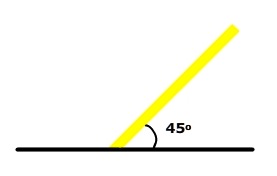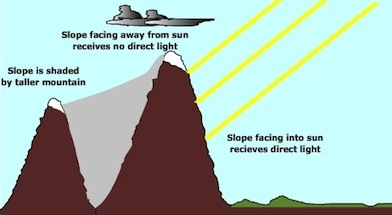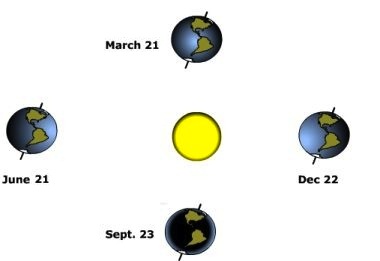Ground Slope and Insolation
The slope of the surface that a beam of light strikes affects the intensity of energy it receives. Slope affects insolation intensity in two ways, 1) the degree of slope inclination, and 2) the orientation of the slope to incoming light.
 Figure 4.11 Effect of changing slope on sun angle (Roll mouse over to view effect)
Figure 4.11 Effect of changing slope on sun angle (Roll mouse over to view effect)
The effect of ground slope is to change the angle that a beam of light strikes the earth (i.e. the sun angle). Figure 4.11 shows a beam of light striking horizontal slope at a 45o angle. Move your mouse over the Figure 4.* to tilt the slope to a 45o while keeping the beam coming to the earth as it was before. By tilting the surface into the Sun, you effectively increase the sun angle. Increasing the sun angle increases the intensity of energy received at the surface.

Figure 4.12 Effect of orientation on insolation.
Orientation, or direction the slope is facing also affects the amount of insolation received. Slopes facing into the Sun receive more while those that face away receive less. Some surfaces can be shaded during a portion of the day by obstructions reducing the amount of insolation received by them.
Figure 4.13 illustrates the effect of orientation on insolation in the mountains of the Cascade Range. Start the movie and watch how slope orientation affects shading. North is at the top of the video. As the sun rises east facing slopes are receiving sunlight while the western slopes are in the shade. As the Sun travels toward the south, the range is aligned parallel to incoming light and both slopes are bathed in sunlight. As the Sun sets in the west in the late afternoon, west-facing slopes are receiving light and eastern slope are in the shade.
Figure 4.13 Daylight simulation in Wenatchee National Forest, Washington
Daylength and Insolation
In Chapter 2 " The Earth System" we discovered that the tilt of the earth's axis and constant parallelism of the earth as it revolves around the sun causes day length to change throughout the year, except for the equator. The circle of illumination always bisects the equator resulting in equal day length, but cuts all other latitude unequally, yielding unequal periods of day and night except for the equinoxes. Simply put, the longer the daylight period, the more insolation received at a given location.

Figure 4.14 Orientation of the Earth to the Sun
